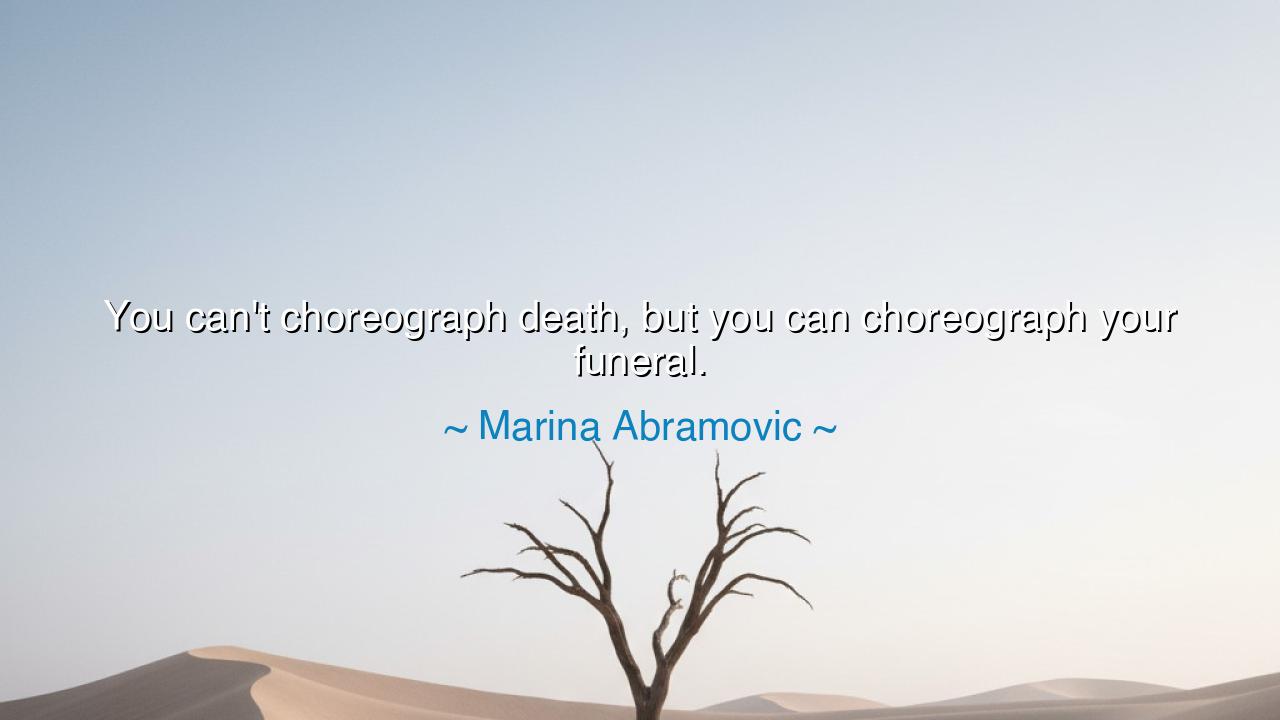
You can't choreograph death, but you can choreograph your






The artist Marina Abramović once said, “You can’t choreograph death, but you can choreograph your funeral.”
In these haunting yet powerful words, she speaks the truth that every mortal soul must one day face: death itself lies beyond our control, but how we meet it — how we shape its echo — remains within the grasp of our will. The dance of life is ours to perform, but the moment of its final silence is not ours to command. Yet even in that inevitability, Abramović finds agency, a space where the human spirit may still express itself — not by defying death, but by dignifying it. Her words, born from her life as a performance artist, reveal a wisdom that reaches beyond art: they are a reflection on the nature of life, mortality, and the meaning we leave behind.
The origin of this quote comes from Abramović’s lifelong exploration of presence, endurance, and the boundaries between art and existence. Known as the “grandmother of performance art,” she has spent her life confronting the physical and emotional limits of being — standing motionless for hours, inviting strangers to harm her, meditating upon pain and stillness. Through her art, she has turned the human body into both temple and battlefield, showing that mortality is the ultimate stage. When she speaks of choreographing the funeral, she speaks not of vanity, but of intention — of shaping the narrative of one’s departure with the same honesty and power with which one has lived. For though we cannot script the moment when life ceases, we can choose the grace of our farewell, the story our leaving will tell.
In the ancient world, this wisdom was well understood. The Stoic philosopher Seneca wrote that death should not be feared, for it is part of the natural order; what matters is how one lives — and how one dies. The ancient warriors of Japan, too, prepared their death poems, written before battle or ritual suicide, to show that in their final breath, they remained masters of their spirit. These were acts not of control over death itself, but of harmony with fate — the understanding that though we cannot choreograph the end, we can shape our attitude toward it. Abramović, in her modern way, echoes this timeless courage: that even in mortality, art — and meaning — remain possible.
To choreograph a funeral is to take death’s cold inevitability and transform it into an act of creation. It is to say: “I accept that I cannot live forever, but I will choose the way my story is remembered.” For in truth, the funeral is not for the dead, but for the living — for those who remain, bewildered by loss, in need of beauty, order, and understanding. When Abramović speaks of this choreography, she invites us to see our lives as art, and our deaths as their final movement — not an ending, but a composition that completes the whole. The soul that has lived intentionally may also die intentionally, leaving behind not chaos, but clarity.
Consider, for instance, the story of Socrates, who, when condemned to death, drank the hemlock calmly, surrounded by his disciples. He did not control the decree of his execution — that was the will of the state — but he choreographed his final moments with serenity, reason, and purpose. His death became a lesson, a living philosophy. He turned what could have been a moment of despair into an act of teaching, an immortal gesture of peace before eternity. His death, like Abramović’s idea, shows us that while fate commands the hour, we command the spirit in which we face it.
This quote also speaks to a deeper truth about human creativity and mortality. To live as an artist — not merely in profession, but in spirit — is to seek beauty and truth even where others see only darkness. Abramović reminds us that death, which so many fear, can also be transformed into meaning. The act of arranging one’s final rites, of imagining the ceremony, the music, the symbols — this is not morbidity; it is an affirmation of life’s continuity. It says, “Even when I am gone, my story will not dissolve into silence; it will be spoken, seen, remembered.” To choreograph one’s funeral, then, is to create art out of impermanence, to give shape to the final breath as one last masterpiece.
So, my child of the living world, take this lesson into your heart: do not fear death, but shape your life so that even death becomes part of your creation. You cannot choreograph the moment your soul departs, but you can choreograph the meaning it leaves behind. Live each day with such truth that your final act — your farewell — will need no embellishment. Fill your life with purpose, compassion, and beauty, so that when your time comes, your passing will not be an end but a continuation of your story’s art.
For the wise understand this: life and death are not opposites, but partners in the same dance. The land ends where the sea begins, and the sea ends where the stars reflect upon it. You cannot command the tide — but you can choose how you meet the waves. So live boldly, love deeply, and when the final curtain falls, let it fall with grace, as Abramović teaches: not with fear, but with the elegance of one who knows that even in dying, there is room for art, meaning, and the immortal gesture of being fully, fearlessly alive.






AAdministratorAdministrator
Welcome, honored guests. Please leave a comment, we will respond soon